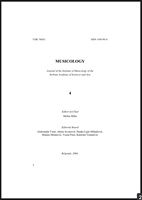Унутарња биографија композитора. Скица за студију о утицајима у делима Љубице Марић
A Composer’s Inner Biography. A Sketch for the Study of Influences in Ljubica Marie’s Oeuvre
Author(s): Melita MilinSubject(s): Customs / Folklore, Music, Cultural Anthropology / Ethnology, Sociology of Art, History of Art
Published by: Muzikološki institut SANU
Keywords: Ljubica Marić; influences; intertextuality; Serbian music;
Summary/Abstract: Attempting to investigate works of music through frank examination possible influences is a delicate thing, sometimes maybe dangerous - as has 1 suggested by Jonathan Cross in his book, The Stravinsky Legacy. While originality of a composer may appear to be threatened with such types of critf for musicologists it is important to draw upon a deeper appreciation for ho composer searched for his/her own creative voice. The music of Ljubica Marie (1909-2003), one of the most important Seri composers of the 20th century, has been chosen to demonstrate how composers n different influences during different phases of their maturation and how they dei integrate them in order to create an individual utterance. Ljubica Marie first studied composition with Josip Slavenski at the Belgi Music School (1925-29), and continued her studies with Josef Suk at the Ma School of the Prague Conservatory (1929-32) where she obtained her diplo Finally, she took Alois Haba’s course in quarter-tone music at the same institu from 1936 to 1937. The works she composed during the 1930’s were character by a radical will to break ties with traditional, mainly romantic music, so she cl to be influenced by the free atonal, pre-dodecaphonic works of Arnold Schoenbei Following World War II, she introduced some changes of expression that v more in keeping with links from the past. Her music became tonally stabilised, thematic-motivic developments were rediscovered, resulting in an expression became milder. But the changes need not necessarily be linked exclusively to post-war climate of socialist realism. Rather, the previous style may have me with some type of impasse - the sort that confounds or ultimately transform! artist. For Ljubica Marie, however, it appears she was never truly satisfied with first post-war works (1945-1950). What is certain is that she composed nothing during the several years preceded her first masterpiece, the cantata The Songs of Space (1956). It is how, worth examining whether or not they were really “dry years”. It is certain that Ljubica Marić, they were fresh discoveries of Serbian traditional singing, both folk and church, poetic and artistic treasures of the Middle Ages - but she also revived earlier experiences (from the pre-war decade) that she had rejected at the time, mainly the music of Stravinsky, Bartók and Slavenski. Although those influences can be detected in the score of The Songs of Space, the work has a strong individual imprint, an identity of its own. In the works that followed, The Passacaglia for orchestra and in several compositions belonging to the cycle Musica octoicha (Octoicha 1, The Byzantine Concerto, Ostinato super thema octoicha, The Threshold of Dreams), original traits of Ljubica Marie’s poetics became even more pronounced. The last works that she produced (in the 1980’s and 1990’s) are all for instrumental soloists or chamber ensembles. They continue with, and refine, the main characteristics of the earlier ones. Ljubica Marie’s evolvement thus presents a search for originality of expression that was reached only after a process of selective assimilation and creative transformation of tradition had been fulfilled - but not until any "anxiety of influences" had been abandoned. It has been shown that Ljubica Marie, like other artists, needed to be ready to be influenced, in order to absorb such influences in a creative way.
Journal: Muzikologija
- Issue Year: 1/2004
- Issue No: 4
- Page Range: 61-82
- Page Count: 22
- Language: Serbian

